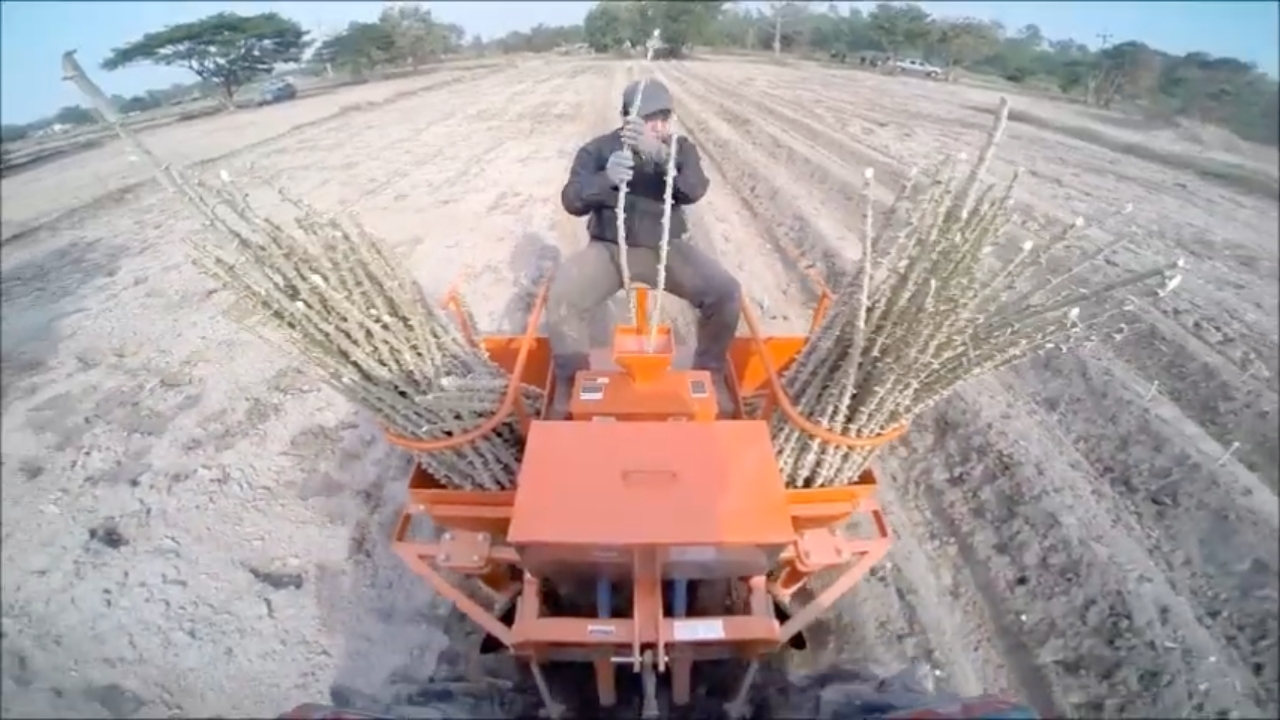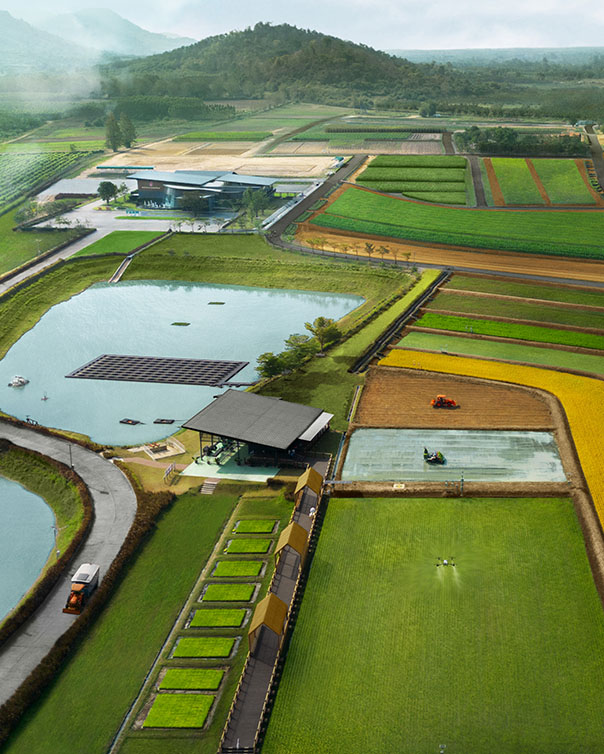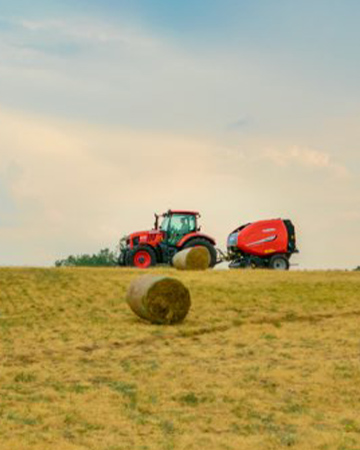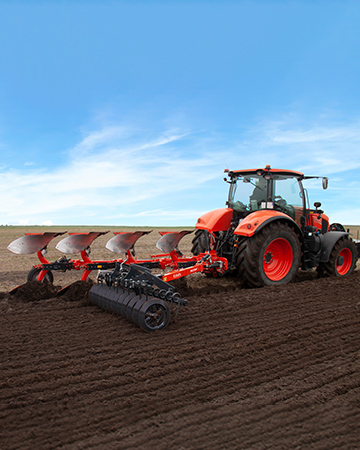
With its small, round shape and mysteriously chewy texture, tapioca’s appeal makes it addictive. It is healthy yet filling and low in calories, making it a good choice for those on a diet. Many shops serving tapioca drinks have opened in Japan, and tapioca treats can be found at cafés, convenience stores, and other locations. But you may not know what goes into making those little tapioca pearls. To find out more about this unknown source ingredient, which is produced in Japan only in small quantities and limited areas, we visited Siam Kubota Corporation Co., Ltd. (SKC), located in the Pathum Thani province of Thailand, a leading tapioca producer. Read on and learn more about this special material and its potential beyond food.

Cassava’s Potential to Save Humanity from Food Shortages and Energy Crisis
Are you familiar with cassava? Many people may have heard the name but do not recognize it. Cassava is a food crop that is native to Central and South America and is grown extensively in the tropics. When the starch from its tuberous root is heated, it becomes tapioca (tapioca pearl in its rounded form). Cassava’s tubers contain a strongly toxic component that turns into cyanide in the human body, so its skin and core must be removed and it must be heated and rinsed to remove this toxic substance before eating. In addition, raw cassava cannot be imported into Japan. This is why people in Japan have few opportunities to see it other than in the form of processed foods.
In recent years, cassava has gained recognition as a crop of importance rivaling that of the three major cereals – wheat, rice, and corn. It can easily be grown in suitable environments, and its yield per unit area is remarkably stable, making it ideal for large-scale cultivation. What is more, its high starch content has led to an increase in its use as a carbon-based resource, including use in bioethanol and bioplastics. Given its versatility, there are growing expectations that cassava could become a global food and energy supply source in the event of a future population explosion or energy crisis.

Cassava Holds the Key to Trade from Thailand to the World
In Thailand, where economic growth rivals that of China and India, there is growing demand for agricultural and construction machinery. Kubota, as part of its aim to become a Global Major Brand, has established SKC as a base in Asia to develop a foothold in Thailand and expand its agricultural machinery business in the ASEAN region. Farming and technology services based on a comprehensive locally-oriented approach are being adapted to local dietary habits and economic activities. To find out more, we spoke with Tatsuya Maeyama, Vice President of SKC, and Nirut Paksasun, SKC's Implement Development Manager (as of 2019).
Cassava really is one of the most popular crops grown in Thailand, isn't it?
“It is. Cassava is one of Thailand's six major crops (which are rice, cassava, corn, sugarcane, rubber, and fruit trees, in order of total area planted), and production amounted to 27.2 million tons in 2018. Thailand's tropical climate and well-drained soil with sandy loam layers make it an ideal place for growing tubers.” (Maeyama)
That’s a huge production volume. How is it mostly used?
“About 70% of it is exported. Cassava has a variety of applications, and it’s interesting how you can clearly tell the industrial needs of the countries to which it is exported. China, which imports the raw tuberous root, uses it to produce bioethanol. For European countries such as Spain and the Netherlands, it is processed into chips and pellets, which are used locally as feed for pigs and other livestock. And Japan makes up a large share of the market for food-use purposes, with large amounts of tapioca starch shipped each year. The remaining 30% is consumed within Thailand and mainly used as starch or feed for livestock. Thailand has been ranked as one of the emerging agricultural-industrial leaders in the ASEAN region thanks to its successes in its farm product processing industry and exports.” (Nirut)

Behind the Development of Agricultural Machinery for Cassava
Agriculture in Japan faces serious labor shortage issues due to elderly farmers leaving the profession, difficulties in finding younger replacements, and high hurdles to newcomers in the industry. How is the situation in Thailand?
“Similar concerns have arisen with the economic growth and globalization making its way throughout the country. The shift from agriculture is progressing, especially among younger generations moving to urban areas, and we're seeing aging populations and labor shortages in certain rural areas. When we think about the impact on future agricultural production, achieving mechanization and taking measures to ensure production efficiency and sustainability will be essential. Reducing labor costs and burden on workers is also important. This is another area that Thailand has in common with Japan.” (Maeyama)
In addition to rice farming machinery, SKC is working to contribute to dry-field farming through development of specialized machinery for cassava, which is essential to Thailand's lifestyle and economy.
“Around 2012, the introduction of new agricultural machinery among rice farmers reached an appropriate level, and dry-field crops were the next step. That is when began development of a planter and harvester for use with cassava. We took that step because those two processes require the most labor. The planter was introduced in 2015, and the harvester in 2018.” (Nirut)

It must be difficult to deal with tubers that grow deep underground, as opposed to rice plants that grow to a uniform height on the surface. What were some of the difficulties you experienced during development?
“Cassava may be one plant, but it has a lot of varieties. It has a wide range of uses as well. We worked with university research institutes and the Thai government to do repeated studies on cassava growth and analysis on soil and fertilizer use. We also visited many farmers growing cassava to research the actual work in their fields and collect data to determine the specs required for mechanization.
With regard to planters, we started by getting a feel for the depth of throwing in, in relation to the height of the ridges, and the speed that could be withstood using continuous tractor operation. In the planting season, which lasts from May to July, we had farmers help us by using prototypes, and did demonstrations repeating the planting process with seed tubers cut to about 25 centimeters and planted at intervals of 60 to 80 cm with ridges of one meter in pitch. Getting the precision we have now took about three years.” (Nirut)

Cutting the cassava seed tubers by hand is a lot of work. The development of the planter has saved farmers that time and effort.

Planting season is from May to July. Roots grow more easily when cuttings are placed in ridges, enabling the tuberous roots to form in about six months, and the crop to be harvested in about one year.
I can imagine that harvesting presented other kinds of issues.
“Actually, with the harvester it was trial and error. For throwing in the seedlings (stems), we were able to conduct year-round simulations at a test farm; however, verifying the harvesting process could only be done during the harvesting season, from around December to March. The tubers are not uniform in size or shape, and because they are underground where we can't see them, it is not easy to dig them up without incurring loss because of damaged or missed tubers. We pursued these issues thoroughly and completed the machine in 2018. It has just been released, and we look forward to seeing how it makes farming more convenient from here onward.”(Nirut)

Advantages of a Design that Reflects Growers’ Needs
What percentage of growers in Thailand and other ASEAN countries have started using cassava machinery?
“At the moment, most growers do all of the work by hand, unless they have especially large fields. Cassava cultivation requires multiple manual processes in planting, fertilizing, and harvesting, and the post-harvesting process in particular requires lots of hard labor, including the use of axes and other tools to cut huge yields of 50-to-70-centimeter tuberous roots and loading them onto trucks. We spoke earlier about the aging of farmers in Thailand and concerns about young people leaving the profession. We are putting effort into educating farmers in Thailand so they can adopt mechanization to keep workloads and personnel costs down while maintaining efficient production to improve their businesses.
In terms of sales, we sold about 400 planters in the two years since they were introduced to the market in 2015 (harvesters have only recently been introduced, so sales figures are not available). We believe this is a good start. Our plan is to first sell them in Thailand and then introduce them to neighboring countries, and we have reached the stage of introducing test machines in Vietnam.”(Nirut)
Are there domestic or international competitors for cassava machinery? What advantages does the Kubota brand offer?
“There are other manufacturers in Thailand. Our advantage is that we can make full use of the results we have achieved by listening closely to farmers’ needs. For example, the lengths of the seed tubers (saplings) vary by region and farmer. They could be 20 centimeters or 25 centimeters, and if the soil tends to be dry, farmers may want to plant them deeper. Kubota planters are set at the generally used depth of 25 centimeters, but the design supports two depths for throwing in the seedlings (stems), which allows it to satisfy both needs. Whether or not planting is done properly can change how sprouts and roots grow, which in turn affects the harvest. Our harvester has also earned an excellent reputation for its ability to dig out the tubers that are firmly rooted in the ground without damaging the roots or leaving any behind, so both of our cassava machines are gaining recognition. I’ll be delighted if more and more farmers can feel that SKC is a dependable partner for them.” (Nirut)


Supporting Mechanization of Agriculture throughout ASEAN is the Goal
You mentioned earlier that machinery for dry-field farming was the next step after rice farming machinery adoption had reached an appropriate level. Are you working on implements for crops other than cassava?
“We have already begun working on planters and harvesters for sugarcane and corn, along with fertilizer application machines that are useful for intermediate management linking the two processes of planting and harvesting.”(Nirut)
Finally, what is SKC's vision for the future?
“Our mission is to contribute to the development of agriculture not only in Thailand but also throughout the whole ASEAN region and in neighboring countries. We will support all aspects of farm management, covering the major crops of Southeast Asia, including rice, cassava, corn, sugarcane, rubber, oil palm, and fruit trees. Our goal is to complete an integrated system for agricultural mechanization from soil preparation and planting to fertilization, pest control and other intermediate management, as well as harvesting. SKC will keep on leading the development of tractors, implements, and specialized harvesting equipment for major crops to offer abundance and stability in food and energy from ASEAN to the world.” (Maeyama)




